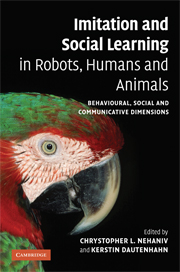 Imitation and Social Learning in Robots, Humans and Animals
Imitation and Social Learning in Robots, Humans and Animals Published online by Cambridge University Press: 10 December 2009
Introduction
In the movie Duck Soup, the Marx Brothers Harpo and Groucho come upon each other, face to face. There would have been a mirror between them, but Harpo, in his attempt to avoid being seen by Groucho whom he had been impersonating, ran into it and broke it. The two men look alike; to avoid detection, Harpo imitates Groucho's movements to make it appear that Groucho is seeing himself in a mirror. Testing the “mirror” image, Groucho performs a series of bizarre actions that Harpo imitates simultaneously, thereby supporting the ridiculous conclusion that Groucho is indeed looking in a mirror. The sequence nicely illustrates the similarities between bodily imitation and mirror images. In both, actions of one entity closely mimic the actions of another, such that a resemblance is apparent. Consequently, it seems reasonable to expect that the same processes that allow someone to imitate another person's actions (or to recognize that one's actions are being imitated) might also be useful in determining that the image in the mirror is oneself.
Remarkably, the first explicit recognition of the similarity between bodily imitation and mirror-self-recognition was quite recent, in 1925 by French psychologist Paul Guillaume, in his book about the imitative development of his daughters. Guillaume (1926/1971, p. 152) argued “We must not hesitate to connect this exceptional mirror experiment [i.e., the child's infrequent interactions with mirrors] with the experience of normal imitation. Other adults and also other children in the society in which he lives are for the infant the natural mirror that reflects for him his own image when he proceeds to imitate.”
To save this book to your Kindle, first ensure [email protected] is added to your Approved Personal Document E-mail List under your Personal Document Settings on the Manage Your Content and Devices page of your Amazon account. Then enter the ‘name’ part of your Kindle email address below. Find out more about saving to your Kindle.
Note you can select to save to either the @free.kindle.com or @kindle.com variations. ‘@free.kindle.com’ emails are free but can only be saved to your device when it is connected to wi-fi. ‘@kindle.com’ emails can be delivered even when you are not connected to wi-fi, but note that service fees apply.
Find out more about the Kindle Personal Document Service.
To save content items to your account, please confirm that you agree to abide by our usage policies. If this is the first time you use this feature, you will be asked to authorise Cambridge Core to connect with your account. Find out more about saving content to Dropbox.
To save content items to your account, please confirm that you agree to abide by our usage policies. If this is the first time you use this feature, you will be asked to authorise Cambridge Core to connect with your account. Find out more about saving content to Google Drive.